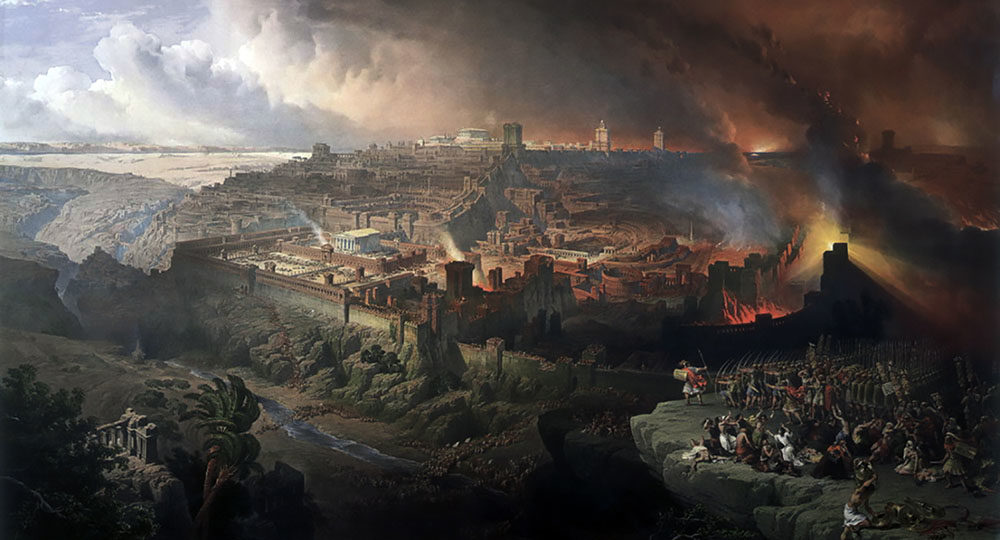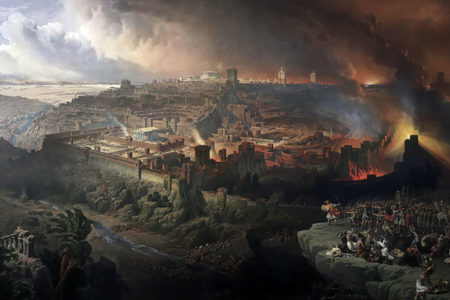Trouble In The Temple: Matthew 23:37–24:2
As with so many important chapters in God’s Word, Matthew 24 actually begins at the end of the previous chapter. The 23rd chapter records what was undoubtedly the hardest-hitting message Jesus delivered during His earthly ministry. Eight times He pronounced judgment on some of the religious leaders of His day by declaring, “Woe unto you, scribes and Pharisees, hypocrites!” (Mt. 23:13, 14, 15, 16, 23, 25, 27, 29). He condemned their selfishness, rapaciousness, misguided zeal, legalism, lack of inner spirituality, and persecution of God’s prophets. The Jewish leadership, however, was simply following in the footsteps of their Old Testament forebears, who had treated God’s earlier messengers just as they were now treating Jesus (see 23:3–36).
His Plea
Although no stronger words ever came from the Savior, He concluded this diatribe with one of the most tender, heartrending pleas recorded in all of Scripture: “O Jerusalem, Jerusalem, thou that killest the prophets, and stonest them who are sent unto thee, how often would I have gathered thy children together, even as a hen gathereth her chickens under her wings, and ye would not!” (Mt. 23:37). Scripture offers no greater example of the uniting of divine holiness and divine love than this statement. After delivering a severe denunciation of sin, Jesus revealed a heart bursting with compassion for sinners. Israel’s “chickens” had simply refused to come under the protective wings of the mother hen! The truth is profoundly clear: If Israel had responded to Jesus’ many invitations to come to salvation, He would have restored them to the land from which they had been dispersed for hundreds of years.
We are reminded that this was not the only time that Israel’s Messiah wept over Jerusalem’s unbelief (see Lk. 19:41). On the western descent of the Mount of Olives sits a lovely chapel called Dominus Flevit (Lat., the Lord wept). Commanding a magnificent view of the Temple Mount and the old city of Jerusalem, this chapel, built in the shape of a teardrop, recalls the broken heart of Jesus, who deeply loved this city and its people in spite of their unbelief.
This plaintive statement revealing the heart of the Savior points out a valuable lesson about salvation. However people view the vexing problem of God’s sovereignty in salvation as it relates to election and predestination, one fact is clear from Scripture: “Let us understand that the ruin of those who are lost, is not because Christ was not willing to save them—nor yet because they wanted to be saved, but could not—but because they would not come to Christ. Let it be a settled principle that man’s salvation is wholly of God and that man’s ruin is wholly of himself” (J.C. Ryle).
His Pronouncement
Jesus concluded His dramatic message to Jerusalem’s religious leaders with two pronouncements. The first concerned the Temple, and the second concerned their attitude toward Him. “Behold, your house is left unto you desolate. For I say unto you, Ye shall not see me henceforth, till ye shall say, Blessed is he that cometh in the name of the Lord” (Mt. 23:38–39). Both of these pronouncements are rooted in Old Testament verses.
In the first, Jesus pronounced judgment on the magnificent Temple where He had just given this message (see Mt. 21:23; 24:1). It would be left “desolate,” devoid not only of people but of the divine presence. In an earlier age, the Prophet Jeremiah issued a similar statement about the first Jerusalem Temple: “But if ye will not hear these words, I swear by myself, saith the LORD, that this house shall become a desolation” (Jer. 22:5; see also Jer. 12:7). Like Jeremiah of old, Jesus condemned the second Jerusalem Temple in similar language. The fulfillment of this dreadful statement took place in AD 70, when the Temple Mount became a desolation as a result of its destruction by the Romans.
The second pronouncement (Mt. 23:39) is the last public word Jesus gave to Israel. Jesus cited the famous messianic text of Psalm 118:26: “Blessed is he that cometh in the name of the LORD; we have blessed you out of the house of the Lᴏʀᴅ.”
In simple terms, Jesus said to Israel’s religious leaders, “You have always rejected the messengers that God has sent to you. Now you have rejected Me. I will no longer preach publicly to you. The next time you see Me publicly will be when you have reversed your attitude about Me. When you no longer say that I am the cursed one but that I am the blessed one, then I will reveal Myself publicly to you again.”
This statement anticipates the future national conversion of Israel spoken about so often in both the Old and New Testaments (see Hos. 5:14–15; Rom. 11:26–27). In modern Hebrew, the terminology Jesus used, “Blessed is he who comes,” is the everyday phrase for welcoming people to a home. In other words, Israel’s leadership had posted a “Not Welcome” sign for their Messiah. When they change that sign to “Welcome,” Jesus will return to them in power and glory.
His Prophecy
“And Jesus went out, and departed from the temple … ” (Mt. 24:1a). This departure was not only physical, it was also symbolic. Jesus left that magnificent structure, the scene of so many of His words and deeds, to its own desolation. At that point some of His disciples volunteered as tour guides: “ … and his disciples came to him to show him the buildings of the temple” (24:1b). Why would they want to show Jesus a building with which He was thoroughly familiar? Their action was no doubt motivated by the dramatic words they had just heard Him utter about this Temple.
Alfred Edersheim, in The Life and Times of Jesus the Messiah, describes the scene well:
They had left the Sanctuary and the City, had crossed black Kidron, and were slowly climbing the Mount of Olives. A sudden turn in the road, and the Sacred Building was once more in full view. Just then the western sun was pouring his golden beams on tops of marble cloisters and on the terraced courts, and glittering on the golden spikes on the roof of the Holy Place. In the setting, even more than in the rising sun, must the vast proportions, the symmetry, and the sparkling sheen of this mass of snowy marble and gold have stood out gloriously. And across the black valley, and up the slopes of Olivet, lay the dark shadows of those gigantic walls built of massive stones, some of them nearly twenty-four feet long … It was probably as they now gazed on all this grandeur and strength, that they broke the silence imposed on them by gloomy thoughts of the near desolateness of that House, which the Lord had predicted. One and another pointed out to Him those massive stones and splendid buildings, or spoke of the rich offerings with which the Temple was adorned (Lk. 21:5). It was but natural that the contrast between this and the predicted desolation should have impressed them.
The Temple truly was impressive. Herod had constructed it of white marble plated with gold, and it shone so brightly in the sun that people could scarcely bear to look at it. Excavations around the western and southern walls of the Temple Mount have revealed a small but graphic picture of the glory that marked this structure. Surrounded by huge porticoes upheld by pillars of marble nearly 40 feet high, this Temple was the center of Judaism and the pride of its people. The rabbis, who had no personal love for Herod, even remarked, “He who has not seen Herod’s Temple has not seen a beautiful building.”
The disciples’ actions reveal their thoughts about the incongruity between what they saw and what they had just heard Jesus say. “Did we hear you correctly, Lord? Did you really mean that this marvelous building will someday be empty, deserted, and desolate?”
Jesus was unequivocal in His response to their offer of a guided tour of the Temple. “And Jesus said unto them, See ye not all these things? Verily I say unto you, There shall not be left here one stone upon another, that shall not be thrown down” (24:2). No statement could have been expressed more clearly or fulfilled more literally. Within 40 years of the time those words were uttered, they were graphically realized in an amazing manner.
In the spring of AD 70, the Roman legions, led by the emperor’s son Titus, approached the Holy City in what would be the last chapter of a rebellion that had begun three years earlier. Camps were built, a siege wall constructed, and battering rams, catapults, and siege engines put in place. By August the walls were breached, and the legionnaires poured into the Temple precincts in a wild frenzy. That beautiful Temple, which the disciples had admired, exploded in a massive conflagration. When the flammable material had cooled, wrecking crews began their work of dismantling the stones that still remained. According to Josephus, the eyewitness historian, the pillars that supported the huge porticoes were 37 1/2 feet high and so thick that three men linked together could not put their arms around them! Cut stones nearly 40 feet in length and weighing more than 100 tons have been found in the walls surrounding the Temple Mount. The pillars were toppled, and the towers were wrecked. The paving stones were ripped up to get at the riches stored in the subterranean vaults. Tradition states that the gold that melted from the conflagration flowed between the flagstones, and greedy soldiers systematically removed them for plunder. Thus, in a tragic but amazing manner, Jesus’ words were literally fulfilled. Absolutely no remains of that magnificent structure are visible today. The stones of the Western or Wailing Wall, site of prayers today, were not part of the Temple itself but of the retaining wall around the mount. According to Josephus, the city was dug up to such an extent that it was difficult to believe it had ever been inhabited.
The physical tragedy of the Temple’s complete destruction is deepened by the spiritual tragedy that caused it. While rabbis later attributed its destruction to the sectarian conflict among the Jewish groups, Jesus gave another reason in the synoptic parallel passage: “For the days shall come upon thee, that thine enemies shall cast a trench about thee, and compass thee round, and keep thee in on every side, And shall lay thee even with the ground, and thy children within thee; and they shall not leave in thee one stone upon another; because thou knewest not the time of thy visitation” (Lk. 19:43–44). The last phrase could be paraphrased, “because you did not recognize the time of God’s coming to you.”
Israel’s religious leaders rejected the Lord of glory and sowed the seeds of the eventual destruction of their Temple, their Sanhedrin, and their city. How tragic are the consequences of refusing to recognize God’s anointed one!







